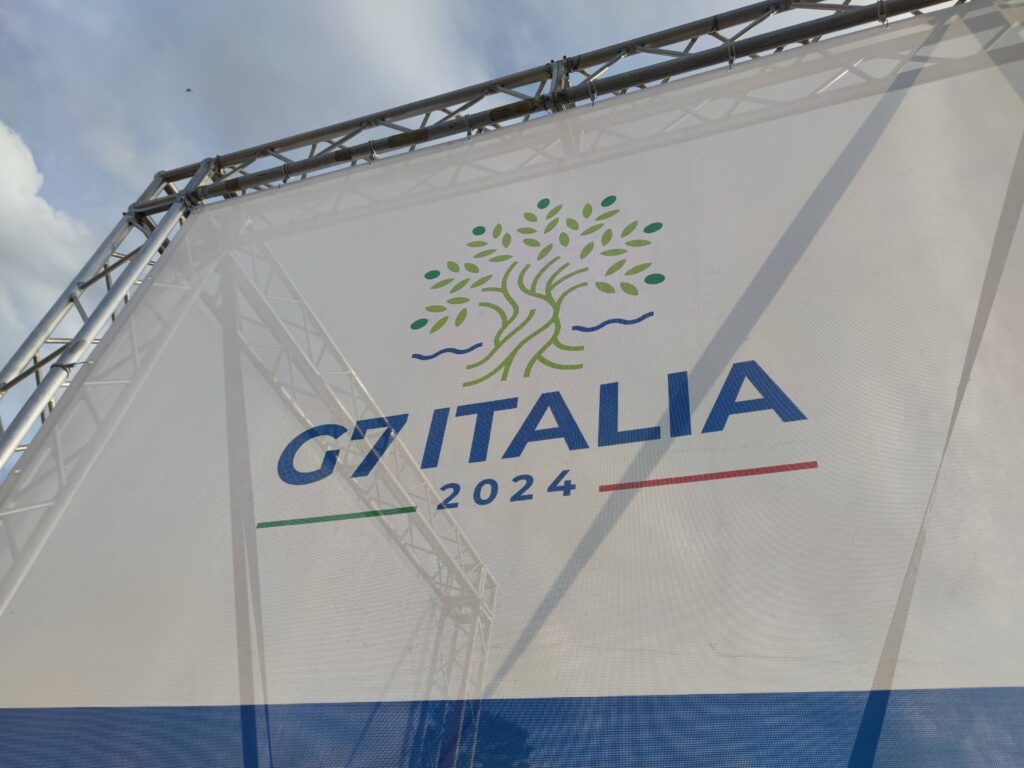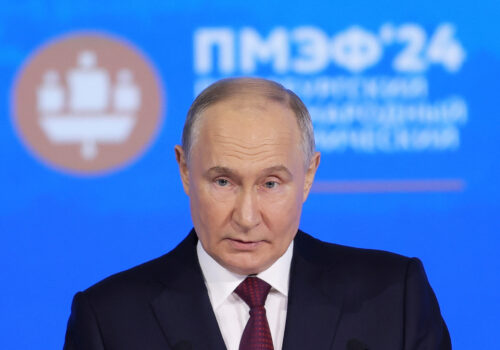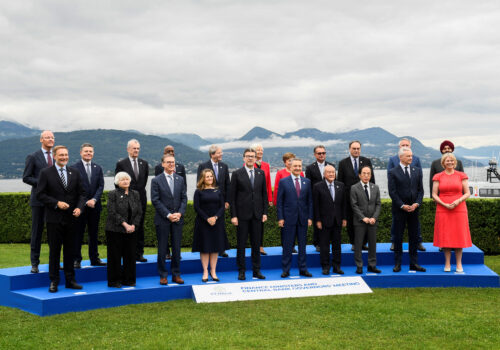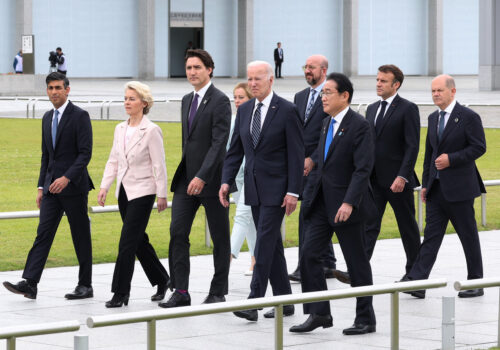Leaders from the Group of Seven (G7) nations are set to convene in Apulia, Italy, on Thursday and face a range of challenges, from how to handle Russia’s immobilized assets to whether they can align on the best way to address China’s surging exports. Then there’s the backdrop: Over half of the leaders are facing elections in the coming weeks and months, and the odds are slim that the group will look the same when they next meet in Canada. Does that provide a sense of urgency or does it present a roadblock for the leaders of the West? Here’s a look inside the numbers that will frame the coming days.
The G7 has an unusually long guest list for the 2024 summit: thirteen world leaders, including the pope. The 2021 summit had four guests, the 2022 summit had six, and the 2023 summit had nine. The bulge in the number of guests reflects the nature and scale of challenges on the G7’s agenda, from wars in Europe and the Middle East to regulating artificial intelligence (AI) to countering China’s manufacturing overcapacity to addressing climate change. Notably, five of the 2024 guests (India, Brazil, South Africa, Saudi Arabia, and the United Arab Emirates) are members of the developing country grouping known as BRICS. While the G7 is trying to show these countries that it can still work together on global challenges, the guests are also eager to indicate that BRICS is not an “anti-West” coalition—yet.
How did the United States outpace the rest of the G7 in gross domestic product (GDP) growth after the pandemic? There’s no one answer. Extraordinary fiscal stimulus, flexible labor markets, productivity growth, and technological leadership, including in AI, all played a role. But the bottom line is that the United States is the fastest-growing advanced economy in the world—and it is not particularly close. To put the US surge in perspective, in the third quarter of 2023 the United States had the same GDP growth as China: 5 percent. That statistic would have been improbable just a few years ago.
Enforcing sanctions and other economic measures against Russia will be one of the main objectives of the G7 summit. Last year, Russia reported a 28.3 percent drop in total exports from 2022. Russian media outlets cited sanctions as an important reason for this decline, specifically the December 2022 European Union (EU) ban on Russian crude oil sold above the G7 price cap. However, Russia has mitigated some of the price cap’s effects by reorienting oil exports to Asia, mainly to China and India. Last month, G7 finance ministers and central bank governors issued a joint statement in which they reiterated their commitment to enforcing the price cap. At the upcoming summit, G7 members should commit to strengthening enforcement with third countries such as China and India to further reduce Russia’s commodity revenues and ability to fund its war in Ukraine.
Inflation across the G7 reached its lowest point since April 2021 by January this year. In the lead-up to the summit this week, the US Federal Open Market Committee held rates steady and emphasized the importance of returning inflation to 2 percent. This follows the first rate cuts last week from the Bank of Canada and the European Central Bank. For Germany and the United Kingdom, both of which experienced a technical recession at some point in 2023, looser monetary policy is long-awaited. Meanwhile, the Bank of Japan faces a more complicated task in managing deflation. But the US Federal Reserve’s 2 percent inflation target still appears to be a distant objective—meaning the United States’ much-anticipated loosening may be put off a bit longer.
At last year’s G7 summit, the leaders pledged both to “drive the transition to clean energy economies of the future through cooperation within and beyond the G7” and to coordinate their approaches to de-risking. The past year suggests that it may be difficult to make progress on these somewhat contradictory objectives. With Chinese manufacturing overcapacity flooding markets, G7 countries have ample incentive to follow the Biden administration in levying higher tariffs on Chinese goods, especially those that compete with infant green energy industries, such as lithium batteries and electric vehicles. The European Commission did just that on Wednesday, proposing higher tariffs on Chinese electric vehicles. What may be beneficial to their domestic industries is not necessarily beneficial to the green transition overall, and coordination on these approaches will be difficult. G7 nations have proven their ability to coordinate since Russia’s invasion of Ukraine, but they are still economic competitors.
Have you ever wondered why it takes your bank account two to five days to show a transaction? Banks and other financial institutions are connected to each other and to a central bank through a payments network, a complicated pipeline consisting of messaging and settlement infrastructure that enables money to move. Usually, your paycheck or rent payments go through a service that is not instantaneous. However, in the past decade, some payments networks have become close to immediate, which allows users to see their transactions settled in less than a day—sometimes in as little as a few seconds.
This type of infrastructure is usually referred to as a fast payments system. There are many economic benefits to fast payments, since they are accessible around the clock to users and can improve businesses’ liquidity, reliability, and usability. While the biggest networks of fast payments are outside of the G7, the group’s member countries have also undertaken measures to create a fast payments system. As the graph above shows, the United Kingdom and Japan have been early adopters of fast payments systems; France, Italy, and Germany enabled their fast payments systems as part of the EU in 2018; and the United States and Canada trail on adoption. The development of a fast payments system is a marker of maturity, innovation, and modernization of the payments infrastructure in a country.
Can the G7 figure out a way to provide fifty billion dollars to Ukraine using immobilized Russian assets? This is perhaps the biggest litmus test of the success of the summit’s success. The issue of the assets has been a hot topic since the day they were blocked over two years ago. As we have long said, the fact that the majority of the money was in Europe (in Belgium’s Euroclear) was going to be the determining factor. For two years, there’s been little agreement on how to make the best use of the money. Earlier this year, there was small progress, with Europe agreeing to use the windfall profits so at least the yearly interest earned on the bulk of the $280 billion could be given to Ukraine. But for many who wanted full confiscation of the assets, that wasn’t enough. Enter the US-led plan to pull forward future interest earnings over the next twenty years. It’s a creative financial solution that is gaining momentum in the G7. The difference it could make is shown above.
Contributions from: Charles Lichfield, Mrugank Bhusari, Ryan Murphy, Josh Lipsky, Sophia Busch, Ananya Kumar, Alisha Chhangani, Kimberly Donovan, and Maia Nikoladze.
Research support from: Clara Falkenek, Gustavo Romero, and Konstantinos Mitsotakis.
Further reading
Tue, Jun 11, 2024
Seven ways to reboot G7 sanctions on Russia
New Atlanticist By Daniel Fried
Russia is adapting to Western sanctions, but there are viable options to intensify the economic hit on its economy for its brutal war on Ukraine.
Sat, May 25, 2024
Experts react: What to know about the latest G7 ‘progress’ on using blocked Russian assets to aid Ukraine
New Atlanticist By
Group of Seven (G7) finance ministers just met in Stresa, Italy, to discuss what to do with blocked Russian assets. Atlantic Council experts follow the money.
Thu, Mar 28, 2024
The G7 needs a permanent secretariat. The 2024 elections cycle demonstrates why.
New Atlanticist By Francis Shin
Establishing a permanent secretariat would enable Group of Seven members to develop more consistent strategies together.
Image: The G7 Summit will be held in Borgo Egnazia (Fasano) in Apulia, on June 13-15, 2024. The event will bring together the Leaders of the seven member States, as well as the President of the European Council and the President of the European Commission representing the European Union. June 12, 2024. IMAGO/dts Nachrichtenagentur.



